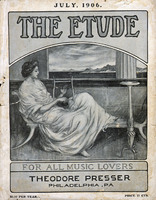Chicago.—Will you kindly inform me whether the stop called “Dulciana” is a string-toned stop or not, and what relation there is between the “Open Diapason” and the “Stopped Diapason.”
Answer.—The Dulciana was invented by Snetzler about the middle of the eighteenth century, and was of a very soft diapason tone. Since that time the stop has been variously modified, according to the fancy of individual builders, and in a few cases has been made with a string tone of the character of a Salicional. In this country the stop is more frequently found in the Choir Organ of three-manual organs, and in the Great Organ of two-manual organs. It is generally a very soft Diapason, and as such is most useful for accompanying the soft solo stops of the Swell Organ. The stop probably has less character than any other stop in the organ, if we may except the Aeoline, which is really an Echo Dulciana in the Swell Organ, but this absence of character is the strong point of the stop, for no more useful stop can be found for accompanying the softest solo stops than a “sleepy Dulciana,” provided, of course, it is not slow of speech.
2. In stop nomenclature the term “Stopped Diapason” seems to be a misnomer, there being absolutely no relationship between the “Open Diapason” and the “Stopped Diapason,” so far as quality of tone or construction of pipe are concerned. The term “Diapason” can be understood to mean “standard.” In which case the “Open Diapason” would be the standard open pipe, and the “Stopped Diapason” the standard stopped pipe. But this interpretation of the two stop names is too far-fetched to be of value. The “Open Diapason” is generally a large-scale, open metal pipe, producing a distinctive diapason tone, while the “Stopped Diapason” is generally a stopped wood pipe, producing a very “flutey” flute tone.
W. H. K.—How are organs compared, with regard to size, and which organ is the largest in the world?
Answer.—The size of an organ is reckoned according to the number of “speaking stops.” All couplers, pistons, combination pedals, and every kind of mechanical accessory should be omitted in naming the size of any organ. Neither has the number of cubic feet which it occupies anything to do with the size of the organ any more than the number of miles of electric wire or tubing. The custom with some builders, when printing the specification of an organ on a program, of arranging every stop, etc., in the organ in numerical order, with accompanying numbers, beginning with the speaking stops and passing through the couplers, pistons, combination pedals, and ending with the wind-indicators, bellows-signal, organ seat, etc., has been misleading, for the organ seat would bear the number “120,” while there were but 75 speaking stops, and many papers have stated that “the organ had 120 stops.”
The largest organ in the world is that which was exhibited in Festival Hall, at the World’s Fair at St. Louis, having 140 speaking stops.
We understand that this organ is still standing in the hall.



